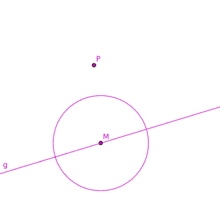Poncelet–Steiner theorem

To draw the parallel (h) to a diameter g through any given point P. Chose auxiliary point C anywhere on the straight line through B and P outside of BP. (Steiner)
In Euclidean geometry, the Poncelet–Steiner theorem concerning compass and straightedge constructions states that whatever can be constructed by straightedge and compass together can be constructed by straightedge alone, provided that a single circle and its centre are given. This result can not be weakened; if the centre of the circle is not given, it cannot be constructed by a straightedge alone. Also, the entire circle is not required. In 1904, Francesco Severi proved that any small arc together with the centre will suffice.[1]
History
The result was conjectured by Jean Victor Poncelet in 1822, and proven by Jakob Steiner in 1833.[2]
See also
- Mohr–Mascheroni theorem, the theorem that any compass and straightedge construction can be performed with only a compass
Notes
- ↑ Retz & Keihn 1989, p. 196
- ↑ Jacob Steiner (1833). Die geometrischen Konstructionen, ausgeführt mittelst der geraden Linie und eines festen Kreises, als Lehrgegenstand auf höheren Unterrichts-Anstalten und zur praktischen Benutzung (in German). Berlin: Ferdinand Dümmler. Retrieved 2 April 2013.
References
- Eves, Howard Whitley (1995), "3.6 The Poncelet–Steiner Construction Theorem", College Geometry, Jones & Bartlett Learning, pp. 180–186, ISBN 9780867204759
- Retz, Merlyn; Keihn, Meta Darlene (1989), "Compass and Straightedge Constructions", Historical Topics for the Mathematics Classroom, National Council of Teachers of Mathematics (NCTM), pp. 192–196, ISBN 9780873532815
External links
- Jacob Steiner's theorem at cut-the-knot (It is impossible to find the center of a given circle with the straightedge alone)
- Straightedge alone Basic constructions of straightedge-only constructions.
This article is issued from
Wikipedia.
The text is licensed under Creative Commons - Attribution - Sharealike.
Additional terms may apply for the media files.